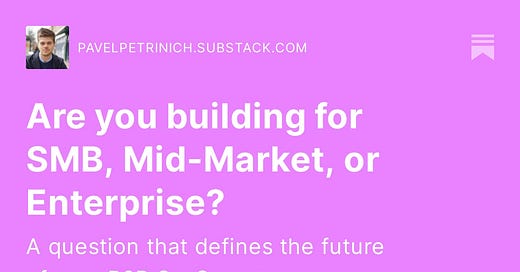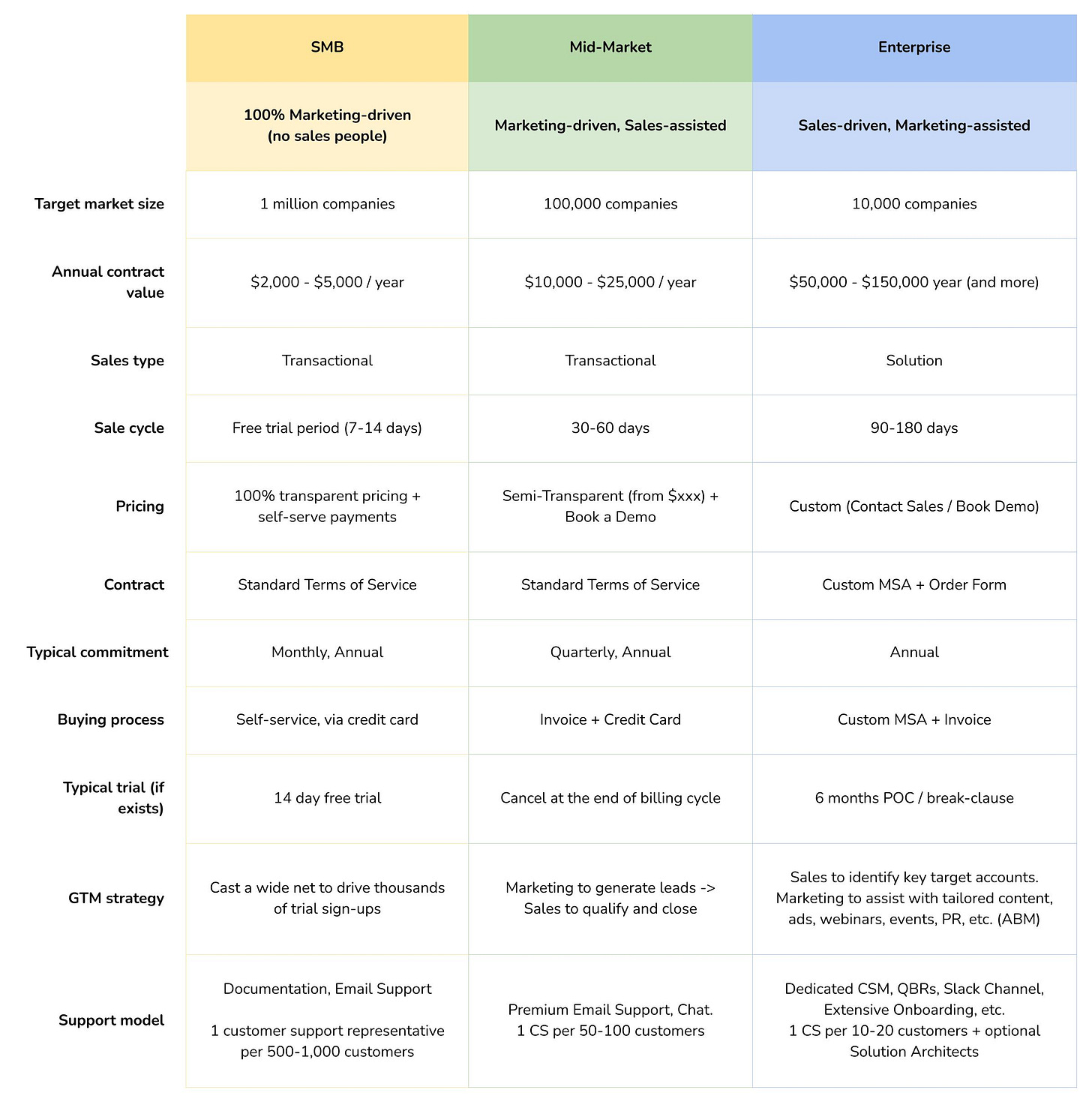Are you building for SMB, Mid-Market, or Enterprise?
A question that defines the future of your B2B SaaS startup
Many founders heavily underestimate the importance of this question and the defining role it will play in their startup journey.
It's not just about having three plans on your Pricing page. It will be a key pillar of many decisions you'll make as a startup founder.
For example:
Key positioning & messaging. For instance, do you want to be viewed as an advanced solution or as an easy-to-use & affordable tool? You only have one home page on your website, after all.
Features to build. Should your product team invest their time in adding security features such as Single Sign-On or 2FA, or should they improve self-service registration & onboarding?
People to hire. Do you need a Head of Marketing with experience in acquiring thousands of self-service users for SMB products, someone who can get you on Product Hunt? Or do you need someone who knows how to bring top-20 enterprise buyers into one room? Given the limited amount of resources as a startup, it's very unlikely that you can hire two.
Competition. Should you really spend your time worrying about competitors that offer similar but more affordable tools for the SMB market? If you know that you are building an Enterprise solution, you won't. But if you can't clearly answer this question, I bet you will panic every time a prospect tells you that you are 'too expensive compared to the competition.’
It also defines your pricing model, acquisition channels, customer success resources, potential partners, and even relevant investors and advisors to approach.
While it's tempting to cover all segments at once, it can create so much distraction and procrastination.
Sure, it is hard to say “no” to potential revenue from a specific market segment, especially when you have some inbound leads coming in. But don't let this ‘demand’ fool you into making a common mistake that many founders made before you.
You can easily avoid this by choosing a single niche to focus on in the next 12-24 months (for example, SMB) and being ready to lose potential customers from a different segment (for example, Enterprise).
But how do you choose?
There is no single answer since it depends on many factors, such as your product (if you already have one), available financial resources, or your personal preference.
However, below are several questions that should be helpful to decide.
SMB: $1k - $5k ACV
Does your product have the potential to be used by 100,000 customers? Can you identify a segment of at least 500,000 businesses (or preferably 1m) that can potentially become customers?
Can you offer trials or a free version of your product?
Can you convert website visitors into paying customers without them speaking to you?
Can one support person be responsible for 500 - 1,000 customers, or even more?
Can you generate at least 1,000 trial sign-ups per month, with at least a 5% conversion rate to paying customers?
In general, customer acquisition in SMB is very similar to promoting consumer services (B2C products) because you need to cast a wide net and target large audiences while also keeping the CAC reasonably low.
If your product is unlikely to be purchased by 100,000 customers even in theory, then SMB may not be an appropriate model to achieve scale (unless you’re okay with it and happy to build a niche but profitable SMB business).
Enterprise: $50k - $150k ACV
If, on the contrary, you are building an advanced/complex solution that requires extensive post-sale customer success/account management resources, it can be difficult to build a sustainable business when targeting SMB or Mid-Market customers.
For example, if one Customer Success Manager can realistically support just 20 clients, you cannot afford to have clients that will pay you less than $5k/month.
The bigger clients will require even more support, so it's better to validate early if your solution is valuable enough to be priced at $100k/year on average.
Ask yourself:
How many companies in your target market can possibly buy your solution at a minimum of $5k/month? Can you literally list all the companies you will go after?
How many of them do you need to convert to customers to hit your revenue targets?
Can you generate enough meetings with relevant stakeholders every single quarter?
Can you validate that companies are ready to pay at least $5,000 per month?
Can you afford the long sales cycles while having serious sales & marketing investment upfront?
Can you support an enterprise sales process from a legal & security standpoint?
Do you have enough headcount both to sell and support these clients post-sales?
Mid-Market: $10k - $25k ACV
This is a tricky segment as you still need to have salespeople & customer success managers, but you cannot invest as much as you could compared to the Enterprise segment.
In mid-market, you need to ensure high velocity and a short sales cycle. You cannot afford a lengthy & complex sales process at just $10k ACV.
Can customers buy your product after just one, maximum two meetings?
Can you close deals quickly, by sharing your Standard invoice & terms?
Can you generate 15-20 meetings per month per one salesperson, with at least a 15-20% conversion rate into customers?
Can one Customer Success Manager handle 50-100 customers at the same time?
Can your clients get up and running in less than a week?
Can you reach your target ICP at scale?
Can you do more than one?
For early-stage startups, my suggestion is to focus on one segment and design your product, team, and go-to-market strategy accordingly.
Once you build a sustainable business in the initial segment, you can start thinking about expansion and experimenting with other customer segments.
In fact, many companies follow exactly this evolution process. For example:
Start in the SMB segment and later add a sales-assisted motion to handle inbound leads from larger companies.
Start with Mid-Market customers in mind and slowly move to Enterprise after a few years. At this point in time, you probably will have enough resources to afford hiring a dedicated enterprise team to sell & support large organizations, as well as adding enterprise-grade features to your product roadmap.
However, if you have decided to sell to Enterprise from the very beginning due to the complexity of your solution, don't go beyond a minimum price point, at least until you have dedicated people to support the high-velocity / low-touch model. It's better to focus on improving your product value proposition than giving it away at half-price, as it can pretty much kill your business.
You don’t have to reinvent the wheel
The good thing about answering the title question is that it also significantly reduces possible procrastination. When you are not clear about your target market (SMB, Mid-Market, or Enterprise), you may get stuck with questions like ‘which features to build,’ ‘which people to hire,’ and which marketing tactics to execute.’
Once you have committed to one market segment, everything else becomes very straightforward in terms of growing your business.
Why?
Regardless of the specific product, many things will be very similar for companies that are going after the same segment (i.e. SMB).
For example, customer acquisition tactics will be mostly the same within each market segment/price range. This means that once you define the market segment you want to focus on, it shouldn’t be too hard to understand what you should be doing to generate the attention of your target customer.
In fact, I suggest you go through the following process to validate this conclusion:
Create a list of 5-10 SaaS companies that sell products at similar price points and have achieved some success. Don’t limit it to your business vertical—look at other similar verticals as well. For example, if you want to build ‘personalization software for enterprise e-commerce companies,’ research ‘enterprise-focused email marketing software’ as well.
Then, find out their customer acquisition tactics. You can do this through simple online research, but it's better to talk to someone who has worked in those companies. Or even better, talk to the founders of these companies, as long as they are not your competitors.
Once you do this research, you'll most likely end up with the same 5-7 tactics. At this point, you will start to see a clear picture of what you should be focusing on and what you should stop doing. This also makes it very clear what your team should look like and for which expertise & experience you should hire.
Summary:
Lack of focus on a single market segment is a classic mistake but totally avoidable.
If you don’t have a straightforward answer to the title question, it may be the right time to think about it and decide if you should change anything in your approach.
For early-stage or future founders, the clear answer to this question (whatever it is) may be a pivotal moment that will save at least a few years of their startup journey.
For later-stage founders, a common focus will help achieve alignment between sales, marketing, and product teams, while also providing mental clarity about the direction where you are going as a company long-term.
“If you chase two rabbits, you will not catch either one”




